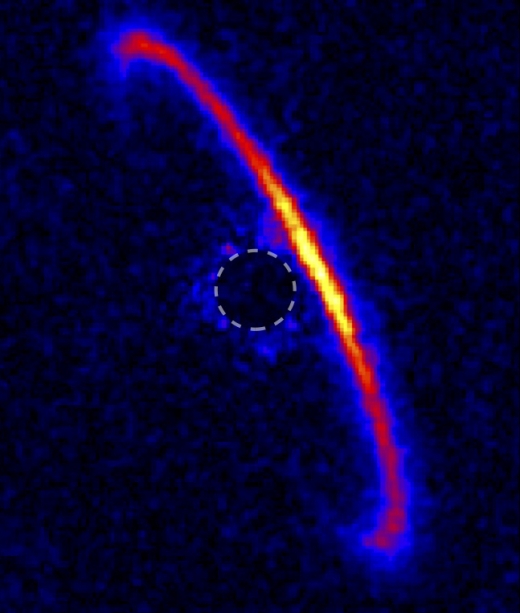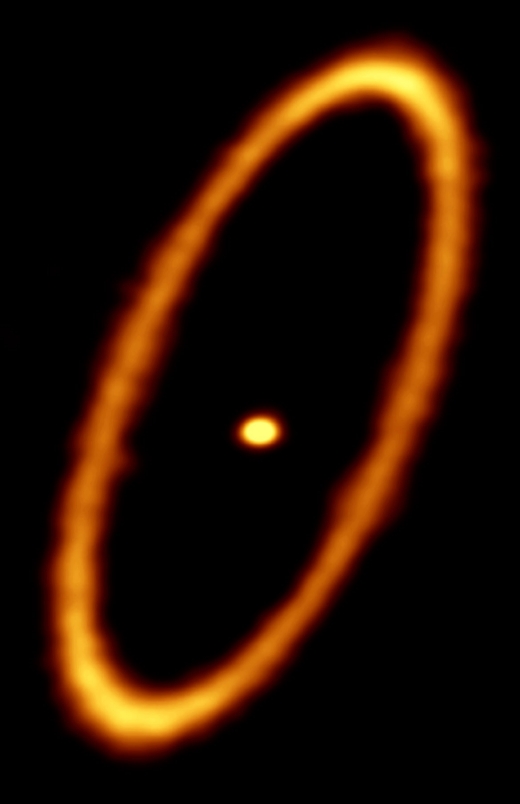Just how do you go about building a ‘super-Earth’? One possibility may be emerging in the study of young debris disk systems with thin, bright outer rings made up of comet-like bodies. Three examples are under scrutiny in work discussed at the recent American Astronomical Society’s Division for Planetary Sciences meeting in Provo, Utah. Here, Carey Lisse (JHU/APL) described his team’s results in studying the stars Fomalhaut, HD 32297 and HR 4796A.
What the scientists are finding is that dense rings of comets can become a construction zone for planets of super-Earth size. The makeup of the material in these ring systems varies, from two that are rich in ice (Fomalhaut and HD 32297) to one that is depleted in ice but rich in carbon (HR 4796A). Take a look at the image below, showing the ring surrounding HR 4796A, and you’ll see how strikingly tight the band of dust around this relatively young stellar system is.

Image: Gemini Planet Imager observations reveal a complex pattern of variations in brightness and polarization around the HR 4796A disk. Credit: Marshall Perrin (Space Telescope Science Institute), Gaspard Duchene (UC Berkeley), Max Millar-Blanchaer (University of Toronto), and the GPI Team.
What causes the dust ring here? Lisse believes its red color is the result of the burnt-out rocky remains of comets, with the ring system close enough to the central star that the original materials have largely boiled off. At Fomalhaut and HD 32297, cometary dust containing ices is found, the ring systems being far enough from the central star that their comets remain cold and stable.
But the tight structure of these three ring systems is still problematic, because in young systems we would expect to see a much less orderly situation as the early era of planet formation proceeds. We also see little circumstellar gas in these systems.
Here we might think of what Cassini showed us at Saturn in the form of small ‘shepherding’ moons that preserve ring structure. Could something similar be happening around these stars, varying according to temperature, as emerging planets begin to take shape? Lisse believes this to be the case:
“Comets crashing down onto these growing planet surfaces would kick up huge clouds of fast-moving, ejected ‘construction dust,’ which would spread over the system in huge clouds. The only apparent solution to these issues is that multiple mini-planets are coalescing in these rings, and these small bodies, with low kick-up velocities, are shepherding the rings into narrow structures — much in the same way many of the narrow rings of Saturn are focused and sharpened.”

Image: ALMA image of the debris disk in the Fomalhaut star system. The ring is approximately 20 billion kilometers from the central star and about 2 billion kilometers wide. The central dot is the unresolved emission from the star, which is about twice the mass of our Sun. Credit: ALMA (ESO/NAOJ/NRAO); M. MacGregor.
This is an interesting model because it distributes planet formation into a series of small processes within the ring structure. Lisse and team believe that in Fomalhaut and HD 32297, they are seeing the formation of planets out of materials supplied by millions of comets, with planetary cores emerging similar to those of the ice giants Uranus and Neptune. But in this case, the gas disks that would contribute to atmospheres are gone. In HR 4796A, with a warmer dust ring, the core building materials are reduced to leftover carbon and rocky debris.
From a recent Lisse et al. paper on this star:
Our results are consistent with an HR 4796A system consisting of a narrow sheparded belt of devolatilized cometary material associated with multiple rocky subcores forming a planet, and a small steady stream of dust inflowing from this belt to a rock sublimation zone at ~1 AU from the primary. These subcores were built from comets that have been actively emitting large, reddish dust for > 0.4 Myr at ~100K (the temperature at which cometary activity onset is seen in our Solar System).
The potential result: The kind of ‘super-Earth’ planets we do not see in our own Solar System (unless we find such in the conjectured ‘Planet Nine’). The Kepler results showed us super-Earths in abundance. Now this cometary ring theory gives us a way to account for their formation. Still to be resolved: The amount of time it is taking for these planets to finish their formation, a period that has been long enough to see the primordial gas in the stellar disks stripped away. Even Lisse concludes that the issue remains ‘a big mystery.’
The paper on HR 4796A is Lisse et al., “Infrared Spectroscopy of HR 4796A’s Bright Outer Cometary Ring + Tenuous Inner Hot Dust Cloud,” accepted at the Astronomical Journal (preprint).



A system like Fomalhaut would be an interesting place to settle with almost unlimited amount of easily available resources.
Who needs planets anyway ?
What I’m really interested in seeing is a study as to what would be the the dynamics of comets in small Red Dwarfs solar systems. Has anyone in the astronomy community written about it and what about any observations they may give a clue as to much cometary matter is around them. There are so many nearby M Dwarfs, could the comet cloud be observed in the infrared? Would they be in a much smaller orbital period?
SCIENTISTS DETECT COMETS OUTSIDE OUR SOLAR SYSTEM.
https://www.astrobio.net/alien-life/scientists-detect-comets-outside-solar-system/
Kepler Space Telescope Discovers First Evidence for Exocomets Transiting Their Stars.
http://www.americaspace.com/2017/08/23/kepler-space-telescope-discovers-first-evidence-for-exocomets-transiting-their-stars/
http://www.americaspace.com/wp-content/uploads/2017/08/comets1.png
http://www.americaspace.com/wp-content/uploads/2017/08/comets2.png
ALMA DISCOVERY OF DUST BELTS AROUND PROXIMA CENTAURI.
Proxima Centauri, the star closest to our Sun, is known to host at least one terrestrial planet candidate in a temperate orbit. Here we report the ALMA detection of the star at 1.3 mm wavelength and the discovery of a belt of dust orbiting around it at distances ranging between 1 and 4 au, approximately. Given the low luminosity of the Proxima Centauri
star, we estimate a characteristic temperature of about 40 K for this dust, which might constitute the dust component of a small-scale analog to our solar system Kuiper belt. The estimated total mass, including dust and bodies up to 50 km in size, is of the order of 0.01 Earth masses, which is similar to that of the solar Kuiper belt. Our data also show a hint of warmer dust closer to the star. We also find signs of two additional features that might be associated with the
Proxima Centauri system, which, however, still require further observations to be confirmed: an outer extremely cold (about 10 K) belt around the star at about 30 au, whose orbital plane is tilted about 45 degrees with respect to the plane of the sky; and additionally, we marginally detect a compact 1.3 mm emission source at a projected distance of about 1.2 arcsec from the star, whose nature is still unknown.
https://arxiv.org/pdf/1711.00578.pdf
‘Monster’ planet discovery challenges formation theory
October 31, 2017
A giant planet – the existence of which was previously thought extremely unlikely – has been discovered by an international collaboration of astronomers, with the University of Warwick taking a leading role.
New research, led by Dr Daniel Bayliss and Professor Peter Wheatley from the University of Warwick’s Astronomy and Astrophysics Group, has identified the unusual planet NGTS-1b – the largest planet compared to the size of its companion star ever discovered in the universe.
NGTS-1b is a gas giant six hundred light years away, the size of Jupiter, and orbits a small star with a radius and mass half that of our sun.
Its existence challenges theories of planet formation which state that a planet of this size could not be formed by such a small star. According to these theories, small stars can readily form rocky planets but do not gather enough material together to form Jupiter-sized planets.
Full article here:
https://scienceblog.com/497175/monster-planet-discovery-challenges-formation-theory/
To quote:
NGTS-1b is the first planet outside our solar system to have been discovered by the NGTS facility, which is situated at the European Southern Observatory’s Paranal Observatory in Northern Chile.
Professor Peter Wheatley, who is from the University of Warwick and leads NGTS, commented:
“NGTS-1b was difficult to find, despite being a monster of a planet, because its parent star is small and faint. Small stars are actually the most common in the universe, so it is possible that there are many of these giant planets waiting to found.
“Having worked for almost a decade to develop the NGTS telescope array, it is thrilling to see it picking out new and unexpected types of planets. I’m looking forward to seeing what other kinds of exciting new planets we can turn up.”
If this red giant star is any indication of just how far our star Sol will expand when it becomes a red giant in a few billion years, then we can assume that Mercury, Venus, and Earth will be vaporized:
http://www.chalmers.se/en/researchinfrastructure/oso/news/Pages/Alma-image-of-red-giant-star-gives-a-surprising-glimpse-of-the-Suns-future.aspx
Of course one way or another, it should not matter to our species long before then. Because we will have spread out into the galaxy and/or found ways to slow down a star’s evolution, right?
Dutch astronomers see moving shadows around planet-forming star
donderdag 9 november 2017, 09:00
A team of mainly Dutch astronomers has observed moving shadows on a dust disk around a star. On multiple days they took a ‘photo’ of the star and its disk.
They used the SPHERE instrument, partially built in the Netherlands, on the Very Large Telescope in Chile. Probably, processes in the inner disk cast their shadows at the outer disk. The astronomers publish their findings in The Astrophysical Journal.
http://www.astronomie.nl/#!/index/_detail/gli/moving-shadows-around-planet-formin-star/